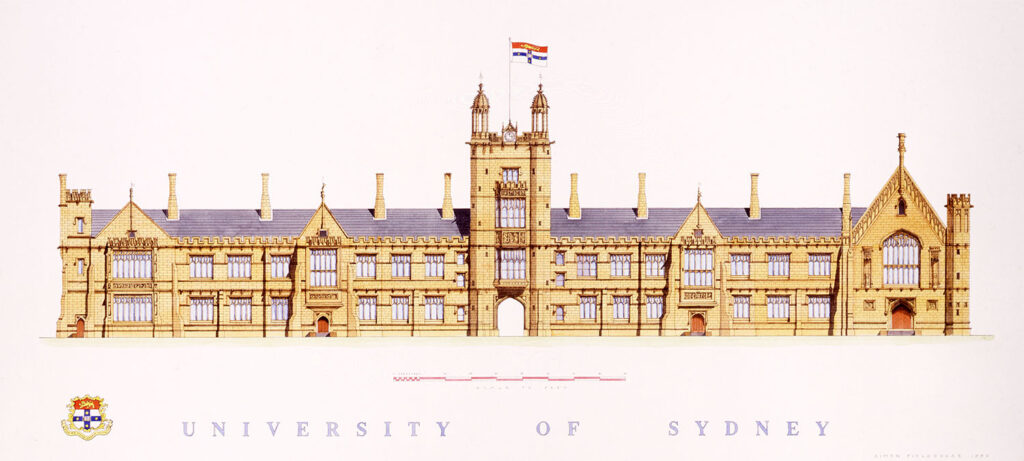
Facade of the University of Sydney
The Main Stone

: A Symbol of Academic Excellence and Architectural Grandeur.The University of Sydney, nestled in the heart of Australia's most populous city, is not only renowned for its academic prestige but also for its splendid architectural heritage. The main stone facade of this venerable institution stands as a symbol of both its commitment to excellence in education and its historical significance in the nation's development.
The University of Sydney's main stone facade, an imposing neoclassical structure, showcases the institution's long-standing tradition of excellence in education. This architectural masterpiece is a reflection of the university's commitment to providing a stimulating environment for learning and scholarship. The main facade, with its Corinthian columns and intricate carvings, evokes a sense of timelessness and permanence. It serves as a reminder to students and visitors alike that the pursuit of knowledge is a noble and enduring endeavor. The grandeur of the facade, with its meticulously crafted details, inspires a sense of awe and reverence, reminding all who pass through its gates of the significance of the academic journey.
Furthermore, the main stone facade of the University of Sydney is not only a symbol of academic excellence but also a testament to the rich history of the institution. Established in 1850, the university is Australia's oldest and one of its most prestigious. The main facade, dating back to the mid-19th century, is a living relic of the university's past. Its sandstone construction, a common building material in the region, reflects the architectural trends of the era. The intricate carvings and classical motifs found on the facade are a testament to the skill and craftsmanship of the artisans who constructed it. As one gazes upon this historic structure, they cannot help but feel a connection to the generations of scholars and visionaries who have passed through its hallowed halls.
The main stone facade of the University of Sydney also serves as a physical representation of the university's enduring commitment to preserving its heritage. It stands as a symbol of the university's dedication to maintaining a link between its past and present. By carefully preserving and maintaining this architectural treasure, the institution ensures that the lessons of history are not lost but are instead cherished and celebrated.
In conclusion, the main stone facade of the University of Sydney is a testament to the institution's dedication to academic excellence and its rich history. It stands as a symbol of the enduring pursuit of knowledge and a physical connection to the university's past. As students and visitors pass through its grand archways, they are reminded of the institution's long-standing commitment to scholarship, the enduring importance of education, and the profound impact that the University of Sydney has had on the nation and the world. This iconic facade is a source of inspiration, a symbol of heritage, and a reminder of the limitless possibilities that await those who enter the doors of this prestigious institution.
Edmund Blacket's architectural style was deeply rooted in the principles of neoclassicism, which is evident in the design of the Quadrangle. The neoclassical style draws inspiration from the classical architecture of ancient Greece and Rome, characterized by features such as grand columns, intricate carvings, and symmetrical layouts. These elements are beautifully incorporated into the design of the University of Sydney's main stone facade.
One of Blacket's notable achievements was his ability to adapt classical architectural principles to the Australian context. He used locally available materials, such as sandstone, in the construction of the facade, which not only connected the building to its surroundings but also showcased the masonry skills of the time. The intricate carvings on the facade, which include various classical motifs, reflect Blacket's attention to detail and his commitment to creating a structure that would stand the test of time.
Blacket's architectural career was marked by numerous significant commissions, and his work extended beyond the University of Sydney. Some of his other notable projects include St. Andrew's Cathedral in Sydney, St. Saviour's Cathedral in Goulburn, and the Great Hall at the University of Sydney. His designs had a lasting impact on the architectural heritage of Sydney and beyond, contributing to the city's rich architectural legacy.
Furthermore, Blacket's work at the University of Sydney's Quadrangle was not only about aesthetics but also about functionality. He designed the Quadrangle to house various academic departments, libraries, and administrative offices, reflecting a commitment to creating a conducive environment for learning and scholarship.
Edmund Blacket's legacy as an architect extended well beyond his own lifetime. His influence can be seen not only in the buildings he designed but also in the broader architectural trends of his era. The neoclassical style, which he embraced and skillfully adapted to the Australian context, continued to be a prominent architectural choice in the 19th century and beyond.
In summary, Edmund Blacket was the visionary architect behind the main stone facade of the University of Sydney. His design, deeply rooted in neoclassical principles, showcases his skill, attention to detail, and adaptability to the Australian landscape. Blacket's work at the university, along with his other architectural achievements, has left an enduring mark on the architectural heritage of Australia, and he remains celebrated as one of the nation's most influential architects.